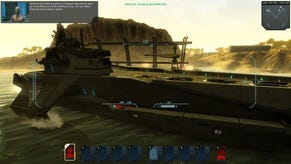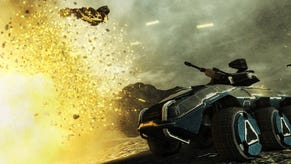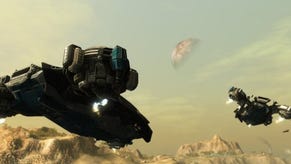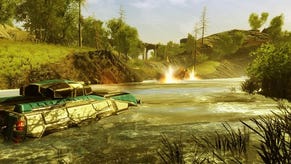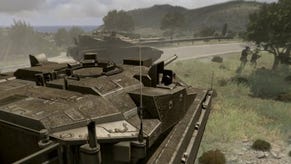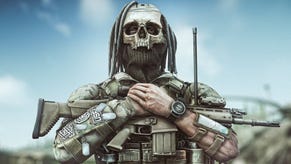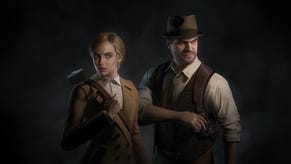Making Of: Hostile Waters
[Another brilliant game which should have been massive - I recall describing it as the first great game of the new millennium, which will annoy anyone who's anal over that Popular Millennium thing. In it I interview Julian Widdows, who I - when writing this - realise I haven't seen for years. Where are you, Julian Widdows? Also, reading it reminds me of one great videogame lost artifact - the Multiplayer Patch for Hostile Waters, which was finished but never released. For God's sake, someone - do the right thing and leak the bastard.]
Sometimes a game’s easy to sum up. For example… Hostile Waters: Lost Classic. There was a time, however that Hostile Waters was captured in a different way. That is, “Carrier Command for a New Millennia”, for that’s what it was. The idea of taking the ancient 80s classic, and riffing furiously off it was Rage’s Dave Percival and Andy Williams, but it was never turned out to be that simple or direct a tribute.
“You may argue, having played Hostile Waters, although you can see the seeds of that in there, it’s very different to Carrier Command,” says Project Manager Julian Widdows, now of Swordfish Studios, “It became clear to us pretty early on that updating it wasn’t going to work. It was a very quiet title.” Good point. While Carrier Command was based around two eponymous carriers and a massive series of islands, explored in a freeform manner, Hostile Waters was a level based Action/RTS hybrid and made good use of Rage’s famed explosion-code. It took a while to actually reach that point, however.
“One of the interesting things about making games is that at the moment there’s few people who differentiate research and development from games development,” Julian says, “We were very much in the R&D phase at the outset, while still having to develop a game on that technology. We were building a technology base, effectively”. The primary problem in this phase that Rage Birmingham, while experienced, had never actually made a strategy game before. “You can’t just reverse engineer other people’s games and make a carbon copy. That doesn’t create a great game,” Julian says, “Sure, it’s possible… but it’s certainly not the best way to go about designing a game”. This R&D state continued for just shy of two years, before amping up to a full – yet still slender – team of eleven people, after which it took almost another year and a quarter to bring it to retail.
“We didn’t set out with the intention of having an extended pre-production title, but we were in a position where we were allowed to build the team up to what we needed in that period. In retrospect, rightly so: it would have increased the cost at the wrong time,” Julian argues, “With all the resources in the world, extended pre-prod is incredibly useful. You can actually work out what you need to know about the game you’re creating.”
Hostile Waters cross-genre basis also proved challenging. Balancing the action and strategy elements satisfactorily proved tricky. “At the time, games like Battlezone were being released, which were very much controlled from the first person,” Julian says, “You were one person, one vehicle. One thing we always wanted in Hostile was the ability to step back from the action. If you’re always in the first person, things get confusing in terms of knowing where all your units are. How do you know what all your units are doing? Audio cues aren’t sufficient. You need to have the ability to take stock of your situation and know where it’s going wrong. But we also wanted the very immediate, visual action where you could pull the trigger yourself, and it felt good. Killing people felt really good. We knew you wanted to be on the floor, looking at the action, feeling the enemy breathing down your front. That engaging dynamic of being engaged in the action”
Their solution, they knew, had to centre on the Carrier itself. This aquatic base was already responsible for the construction of your individual units, but perhaps it could find another purpose? “What if you could take stock of the situation in the carrier as well here, in another room?,” Julian adds rhetorically. This lead to a map and the ability to add way-points, select and move around units. However, this choice lead to a pivotal moment in the game’s development. “I think the key decision we made, and probably the most important thing we did, was to pause the game while you were in there,” Julian says, “This changes the dynamic of Hostile Waters immeasurably. You really can take stock. You can think carefully in a controlled and relaxed way what aspects of the game you’d like to focus on.”
However, they didn’t want to reduce the game to a mere distant control. “We made it as simple and easy as possible to give orders to units in the game, so you didn’t have to go back to your carrier,” Julian says, “You could say “You – go over there”, and it worked and felt satisfying.” The balancing the two desires proved awkward. But, as Julian says, “It’s what made Hostile Waters unique in its way, is that you could really take control or take a back seat depending where you are. If you want it to be a good action/strategy title. The key thing is that it has to be fun to control the vehicle and pull the trigger, because if it’s not people won’t play it like that, and just play it like a strategy title… and that would have ruined it.”
Hostile Waters also brought in an external writer, in the form of the abrasively entertaining comic-writer Warren Ellis, which added much to the game fiction. “Our strength was designing games, not script-writing,” Julian states, “We wanted a high quality story, with cut-scenes as a reward for completing the level. We also knew the challenge for this would be that the story and the game are so closely entwined, it’s very difficult to keep the script current. You have to change it endlessly.” In other words, every time a level changed, the writer would have to rewrite something. Clearly this would be an impossibility in terms of having a writer on constant demand for months. The team hit a novel solution. “We had Warren write cinematics which had nothing to do with the main game narrative: he would do backstory about the world and the carrier,” Julian says, “William Burroughs had something called The Folding Technique, where he’d say you could take chapters and re-arrange them in any order, and it would still make sense. And you could argue whether that was actually true or not, but it was certainly true in Hostile’s cinematics. We wanted to tell the game narrative in the level, but do these ambitious, different cinematics for /completing/ a level. It wouldn’t patronise you by telling you what you’ve just done.”
In the end, Hostile Water’s critical success and commercial failure proved bittersweet. “We’re proud that we got it out… and we’re most proud that the people who bought it really, really liked it,” Julian says, “We got some phenomenal reviews. Including stuff like “The best game you’ve never played”. And still people show interest in the game. I hate saying this, even though I say it every single time, I know that deep down in our souls, we do this for one reason, which is to do good games that people enjoy playing. There’s not one of here who’s driving around in a Ferrari, or swimming pools or a harem of girls.”
However, despite its lack of success in terms of money, it wasn’t a loss, it was far from useless. “It did a huge amount of good – what it didn’t make back in money, it made back in reputation for the companies who were involved.” It was this groundwork which helped Rage Birmingham to reform as Swordfish Studios when Rage collapsed financially. “I wish we shipped with multiplayer,” Julian Widdow says, “Then Edge would have given it nine”. As it was, the publisher didn’t want to have a multiplayer game, despite the huge popularity of strategy-based multiplayer at the time. Not that, as it turns out it stopped them. “We did actually do a multiplayer patch, and there’s a LAN version of Hostile Waters which we completed. But we completed it the day Interplay went to the wall, who were distributing it… and it never got shipped.” Due to a complicated legal situation, it was never released.
Rage’s biggest regret about Hostile Waters and now ours too.





